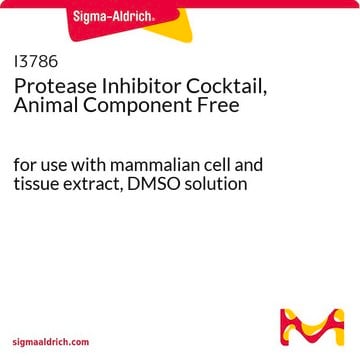539136
Protease Inhibitor Cocktail IV
liquid, for the inhibition of serine proteases, cysteine proteases, aspartic proteases and metalloproteases. This small molecule/inhibitor is primarily used for Protease Inhibitors applications.
Synonym(e):
Protease inhibitor cocktail
About This Item
Empfohlene Produkte
product name
Protease Inhibitor Cocktail Set IV, The Protease Inhibitor Cocktail Set IV controls the activity of Protease. This small molecule/inhibitor is primarily used for Protease Inhibitors applications.
Form
liquid
Hersteller/Markenname
Calbiochem®
Lagerbedingungen
OK to freeze
Versandbedingung
wet ice
Lagertemp.
−20°C
Verwandte Kategorien
Allgemeine Beschreibung
Spezifität
Anwendung
Biochem./physiol. Wirkung
aspartic-, cysteine-, metallo-, and serine-proteases
Warnhinweis
Physikalische Form
Rekonstituierung
Sonstige Hinweise
Rechtliche Hinweise
Signalwort
Warning
H-Sätze
Gefahreneinstufungen
Acute Tox. 4 Oral - Aquatic Acute 1 - Aquatic Chronic 1 - Eye Irrit. 2 - Skin Irrit. 2
Lagerklassenschlüssel
10 - Combustible liquids
WGK
WGK 3
Flammpunkt (°F)
188.6 °F - Information refers to the main ingredient.
Flammpunkt (°C)
87 °C - Information refers to the main ingredient.
Analysenzertifikate (COA)
Suchen Sie nach Analysenzertifikate (COA), indem Sie die Lot-/Chargennummer des Produkts eingeben. Lot- und Chargennummern sind auf dem Produktetikett hinter den Wörtern ‘Lot’ oder ‘Batch’ (Lot oder Charge) zu finden.
Besitzen Sie dieses Produkt bereits?
In der Dokumentenbibliothek finden Sie die Dokumentation zu den Produkten, die Sie kürzlich erworben haben.
Kunden haben sich ebenfalls angesehen
Unser Team von Wissenschaftlern verfügt über Erfahrung in allen Forschungsbereichen einschließlich Life Science, Materialwissenschaften, chemischer Synthese, Chromatographie, Analytik und vielen mehr..
Setzen Sie sich mit dem technischen Dienst in Verbindung.
















